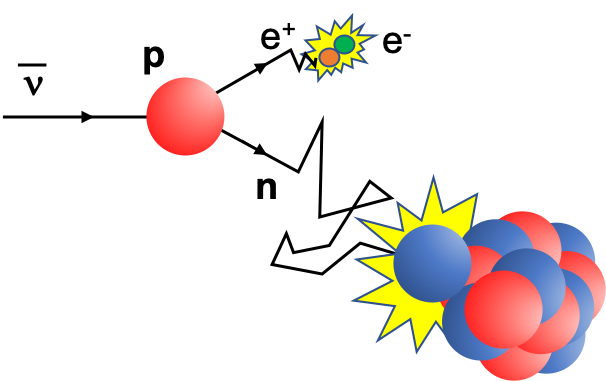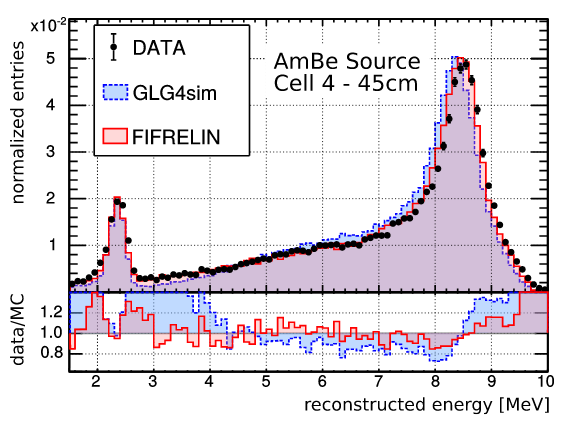The FIFRELIN code simulates nuclear fission and de-excitation of the nuclei produced therein. Stereo is a compact neutrino detector that looks for a hypothetical sterile neutrino. Two a-priori disjoint topics, which have however recently met to achieve unprecedented precision on a crucial ingredient in the detection of neutrinos: the de-excitation of a gadolinium nucleus after the capture of a neutron. The results of this meeting have just been published in the journal EPJA.
The Stereo experiment aims to test the existence of a sterile neutrino by looking for oscillations of the standard electron anti-neutrinos produced by the research reactor of ILL Grenoble. Although 4·1015 neutrinos, resulting from the beta decays of the fission products, pass each second through the 2 m3 of scintillator liquid of the detector, only one neutrino is intercepted every 4 minutes. If a sterile neutrino exists, it will induce an oscillation in the number of active neutrinos detected, visible by comparing the spectra measured in the 6 cells of Stereo (Figure 1).

Figure 1: Schematic of the design of the Stereo detector. © L. Scola, CEA
 Figure 2: Neutrino detection process in Stereo. The incident neutrino interacts with a hydrogen nucleus of the liquid scintillator to form a positron (e+) and a neutron (n) which, in most cases, will be captured by a gadolinium nucleus. © D. Lhuillier, CEA
Figure 2: Neutrino detection process in Stereo. The incident neutrino interacts with a hydrogen nucleus of the liquid scintillator to form a positron (e+) and a neutron (n) which, in most cases, will be captured by a gadolinium nucleus. © D. Lhuillier, CEA
 Figure 3: Illustration of the distribution of excited levels of a nucleus. The density increases very rapidly with the excitation energy. In this example, the initial state, whose energy Sn (neutron separation energy) is of the order of 8 MeV, is de-excited by emitting 3 gamma rays to the ground state (G.S.). © O. Litaize, CEA
Figure 3: Illustration of the distribution of excited levels of a nucleus. The density increases very rapidly with the excitation energy. In this example, the initial state, whose energy Sn (neutron separation energy) is of the order of 8 MeV, is de-excited by emitting 3 gamma rays to the ground state (G.S.). © O. Litaize, CEA
 Figure 4: Comparison between experimental energy (points) and simulated (histograms) distributions of gamma-rays detected in Stereo after a neutron capture. Neutrons are generated by a radioactive source placed halfway up a cell. © H. Almazán Molina, MPIK
Figure 4: Comparison between experimental energy (points) and simulated (histograms) distributions of gamma-rays detected in Stereo after a neutron capture. Neutrons are generated by a radioactive source placed halfway up a cell. © H. Almazán Molina, MPIK
With such a low rate of neutrinos, one must be able to reject all other signals (natural radiation, reactor activity) that could mimic the signal of a neutrino. Fortunately, physicists have a rather unique signature of the interaction of a neutrino with a proton of the detector: the detection of a positron followed by the capture of a neutron (Figure 2). To make this process more efficient, gadolinium (Gd) is blended with the scintillator liquid. This element holds the record of appetite for neutrons. In just a few microseconds, it will capture the neutron produced by a neutrino and emit a cascade of gamma rays to signal its capture with a total energy of 8 MeV, well above most disturbing signals.
The oscillations sought by Stereo develop at the scale of meters. The detector is therefore compact and a non-negligible part of the gammas of the cascade will escape the liquid scintillator. The nice signal expected at 8 MeV will thus be adorned with a broad low energy tail, filled with all these partial energy deposits of the cascade. A detection cutoff is applied to stay above the background (typically, energies above 4.5 MeV are selected). But Stereo wants to control its detection efficiency to the %-level, so it is necessary to describe very precisely the gamma cascades of Gd.
At this point FIFRELIN, being well acquainted with the complex terrains of gamma cascades, enters the stage. It is a Monte Carlo code developed at CEA / DEN Cadarache that simulates the production and de-excitation of fission fragments to meet nuclear data needs for reactor physics [1]. In particluar, FIFRELIN is capable of modelling the emission cascade of gammas and electrons resulting from the de-excitation of a nucleus created by neutron capture. To do this, it uses all available nuclear structure data that describes the first excited levels. But after absorption of a neutron, the excitation energy of the Gd nucleus reaches a continuum of levels (Figure 3).
FIFRELIN is then based on level-density models to complete the level schemes. After calculating all the probabilities of partial inter-level transitions, the code samples millions of electromagnetic cascades, while simultaneous controlling the number and energy of the gamma rays. These cascades are then used in the simulation of the Stereo detector response.
Figure 4 illustrates the improvement obtained, thanks to FIFRELIN, in the description of the energy measured after the neutron captures. Capture peaks on Gd (8 MeV) and to a lesser extent on hydrogen (2.2 MeV) are clearly visible. The initial agreement obtained with the GEANT4 simulations, illustrated by the graph in blue, seems satisfactory, but the residual distortions were nevertheless sufficient to generate 4.5% difference between the simulated and measured detection efficiencies for a neutron source in the center of a cell. Thanks to the FIFRELIN simulations (red graph), the agreement becomes almost perfect. This is the case for the alignment of the peaks as well as the distribution of intermediate energies, very sensitive to the description of the cascades. The agreement between simulation and data reaches down to only 0.5%, with an associated sub-% level uncertainty [2].
A fruitful meeting that comes at the right time for Stereo's pursuit of high precision! The technology of Gd-doped scintillators is widely used for neutrino detection. This advancement towards high precision will be beneficial to several other ongoing projects. In parallel with the publication of these results, 10 million Gd cascades have been made available to the scientific community [3].
References:
[1] O. Litaize et al., “Fission modelling with FIFRELIN”, EPJA, 51 (2015) 177
[2] H. Almazán et al., “Improved STEREO simulation with a new gamma ray spectrum of excited gadolinium isotopes using FIFRELIN”, EPJA, 55 (2019) 183
[3] H. Almazán et al., “Data from: Improved STEREO simulation with a new gamma ray spectrum of excited gadolinium isotopes using FIFRELIN”, Zenodo, 2653786 (2019)

